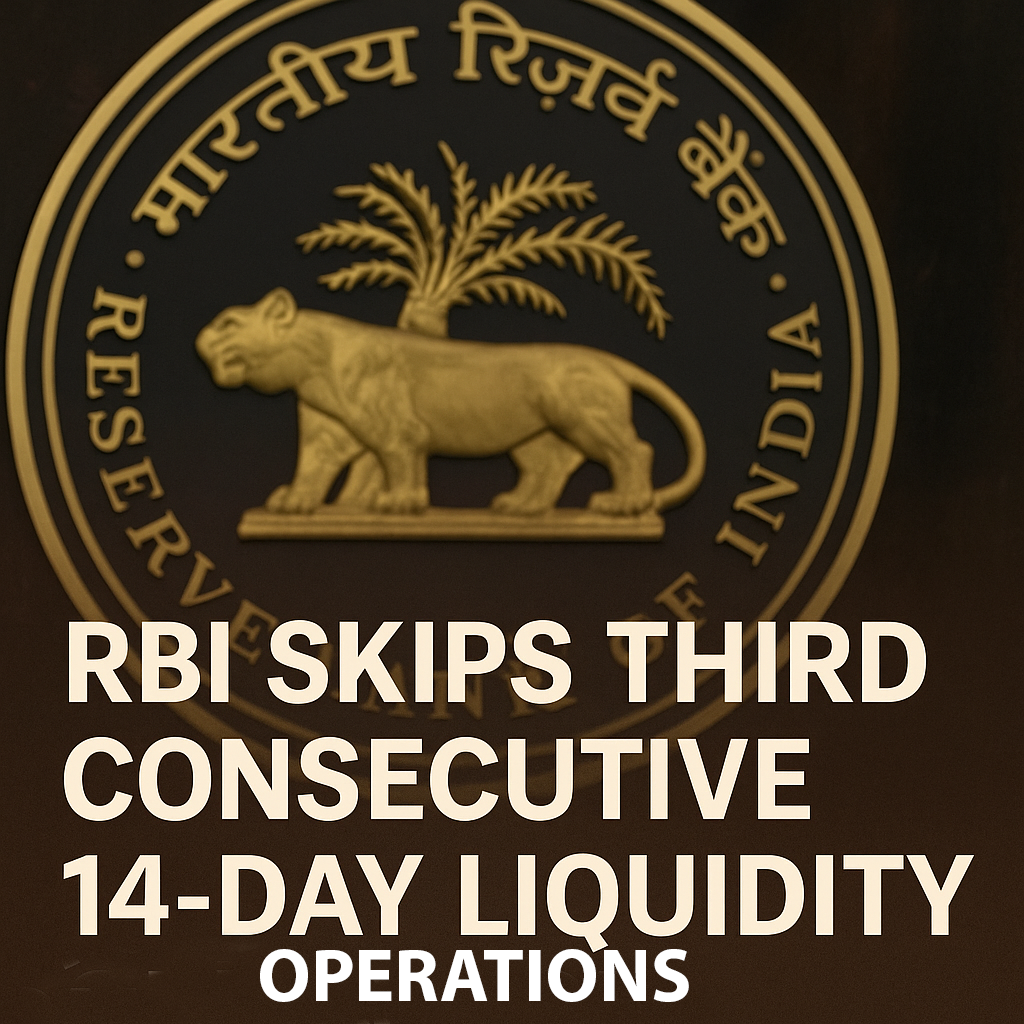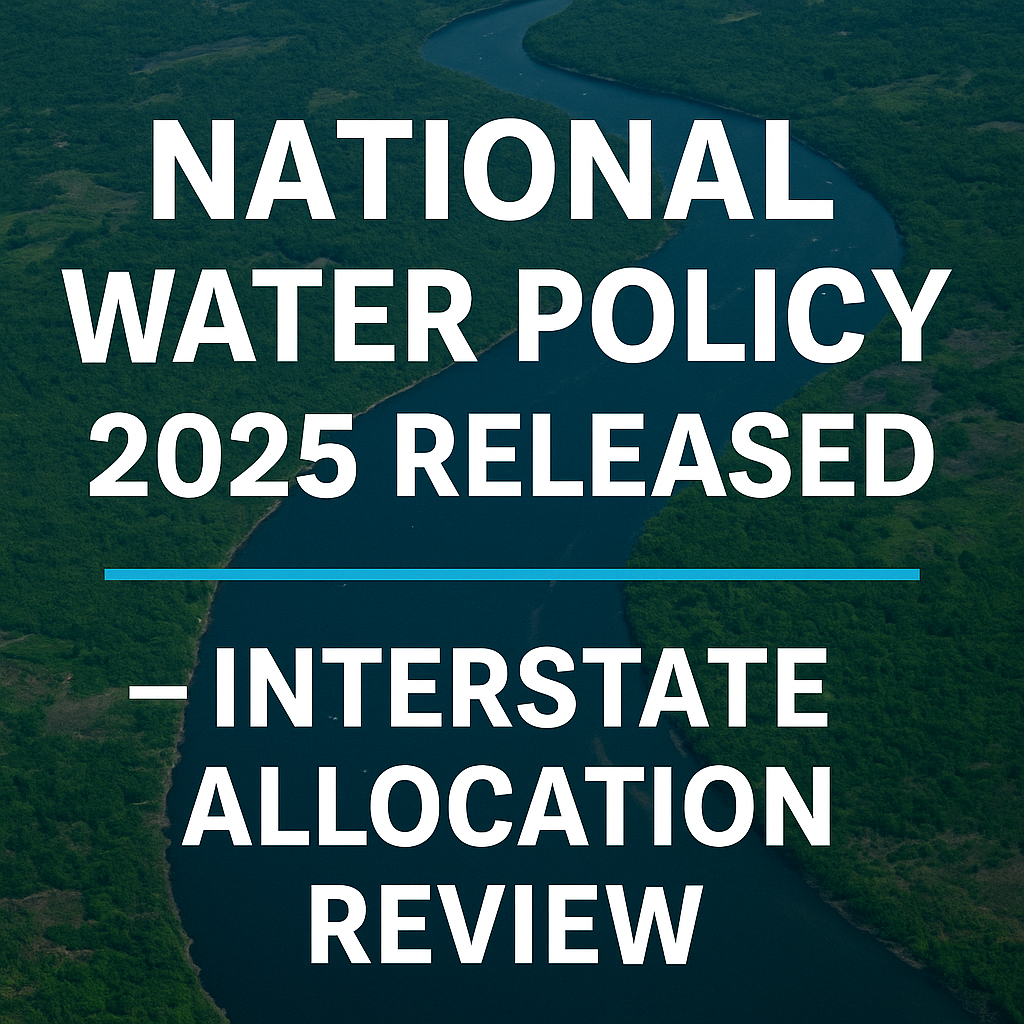
🧭June 12, 2025 Post 1: RBI Skips 14-Day Repo for 3rd Time: Signals Confidence Amid Liquidity Surplus | High Quality Mains Essay | Prelims MCQs
RBI Skips 14-Day Repo for 3rd Time: Signals Confidence Amid Liquidity Surplus

NATIONAL
📅 Post Date: June 12, 2025
📘 Thematic Focus: Monetary Policy | Liquidity Management | Macroeconomic Stability
🌿 Opening Whisper
“Sometimes, the strongest move is the one not made.”
🔍 Key Highlights
- The Reserve Bank of India (RBI) did not conduct the 14-day variable rate repo (VRR) for the third consecutive fortnight (June 12, 2025), despite a standing schedule.
- This decision comes amid a ₹2.6 lakh crore liquidity surplus in the banking system.
- The surplus is attributed to muted government spending, sustained capital inflows, and cautious credit offtake.
- RBI may be preempting a liquidity outflow toward advance tax and GST payments due mid-June.
- The pause is seen as a non-verbal signal of policy comfort, aligning with recent 100 bps rate cuts and a declining inflation trajectory (May CPI: 2.82%).
- Meanwhile, the 14-day VRR reverse repo auctions continue to manage excess liquidity on the absorption side.
📘 Concept Explainer: What Is the 14-Day Variable Rate Repo (VRR)?
- A liquidity injection tool used by RBI to lend money to banks via auction at a variable interest rate.
- Typically conducted on alternate Fridays, it allows banks to borrow short-term liquidity.
- Skipping a VRR implies RBI sees sufficient liquidity in the system and prefers to wait for natural absorption via taxes or bond sales.
- It also helps avoid overheating or excess liquidity-driven inflation, especially after recent rate cuts.
🧭 GS Mains Mapping
- GS Paper 3 – Indian Economy | Monetary Policy Tools | Liquidity Management
- GS Paper 2 – Government Budgeting (GST/Advance Tax Impact on Markets)
💭 A Thought Spark — by IAS Monk
“The central bank’s silence is not absence—it’s a calculation. In liquidity lies the rhythm of the economy, and sometimes the beat must pause to preserve the harmony.”
High Quality Mains Essay For Practice :
Word Limit 1000-1200
Monetary Silence, Market Signal: RBI’s Pause on 14-Day Repo and Its Strategic Meaning
Introduction
In the world of central banking, inaction can often speak louder than intervention. The Reserve Bank of India (RBI) demonstrated this nuance on June 12, 2025, when it skipped the 14-day variable rate repo (VRR) auction for the third consecutive fortnight, despite market expectations and systemic protocols. This subtle move—devoid of press conferences or policy tweaks—signals the RBI’s growing confidence in the liquidity environment, and is being interpreted as a strategic calibration of tools to manage both inflation and market expectations.
In a context of surplus liquidity exceeding ₹2.6 lakh crore and falling inflation (CPI at 2.82%), the central bank’s pause reveals a shift in its tactical thinking. The essay explores the rationale behind this decision, its implications for financial stability, and the evolving contours of RBI’s monetary strategy.
The 14-Day VRR Operation: What Is It?
The 14-day Variable Rate Repo (VRR) is a key liquidity injection tool used by the RBI. Under this mechanism:
- Banks borrow funds from RBI at a variable interest rate determined via auction.
- It allows banks to meet short-term funding needs, especially during periods of deficit liquidity.
- Typically conducted fortnightly, it complements other liquidity operations like the overnight fixed-rate repo, reverse repo, and long-term repo operations (LTROs).
Skipping the VRR indicates that the RBI believes liquidity conditions are comfortable, and does not see the need to actively pump funds into the system.
Context: Why Did RBI Skip the Operation?
1. Liquidity Surplus in the System
The Indian banking system is currently flush with liquidity. As of June 2025:
- The net surplus exceeded ₹2.6 lakh crore, owing to:
- Reduced government spending in Q1 of FY26
- Sustained foreign capital inflows
- Weak credit demand due to post-repo-rate-cut transmission delays
Injecting more liquidity through a VRR would be unnecessary, and could even risk inflationary pressures.
2. Advance Tax & GST Outflows Expected
- Mid-June marks quarterly advance tax deadlines and monthly GST settlement dates.
- These tax-related outflows are expected to naturally absorb surplus liquidity, reducing the need for RBI action.
3. Recent 100 bps Rate Cut
- The RBI recently executed a 100 basis point reduction in repo rate (across April-May 2025).
- Skipping the VRR complements that easing stance, while ensuring liquidity doesn’t exceed thresholds and create asset bubbles.
4. Silent Signaling to Markets
In monetary policy, sometimes inaction is intentional communication. By skipping VRR:
- RBI signals calm and confidence in the liquidity environment.
- Markets interpret it as a non-verbal reaffirmation that inflation remains under control, and policy normalization is proceeding as planned.
Implications for the Financial Sector
A. Banking Sector Behavior
- Banks with surplus funds are now forced to park them in reverse repo or Treasury Bills, rather than borrow more.
- This encourages prudence in liquidity management, curbs reckless lending, and encourages reallocation toward government securities.
B. Short-Term Interest Rates Stabilization
- Skipping VRR puts slight upward pressure on call money rates, helping anchor them near the repo rate.
- It avoids excessive softening of short-term yields, which is crucial to maintaining financial discipline.
C. Bond Market Confidence
- The decision reassures bond investors that the RBI is not in panic mode, despite low inflation.
- Long-term bond yields may remain stable or soften modestly, helping government borrowing.
Broader Strategic Interpretation
1. Evolution of RBI’s Tactical Toolkit
Gone are the days when RBI relied solely on rate hikes or cuts. The post-pandemic era has seen a sophisticated, layered approach involving:
- VRR and VRRR (Variable Rate Reverse Repo)
- LTROs and OMOs (Open Market Operations)
- Standing Deposit Facilities (SDF)
By skipping a VRR, RBI is using passive tools to influence liquidity without altering headline rates.
2. Inflation-Targeting with Flexibility
While the official inflation target remains 4% ± 2%, the RBI is now focusing on liquidity-based anchoring to manage volatility. Skipping VRR:
- Prevents excessive liquidity-driven demand
- Buys time to assess the sustainability of the low CPI trend
3. Preparing for Policy Transition
The global economic outlook remains uncertain, with:
- Potential oil price volatility due to Middle East tensions
- Weakening Chinese exports
- Sticky US inflation
RBI’s measured approach ensures that it doesn’t overcommit to one policy stance, preserving room to maneuver if global shocks emerge.
Lessons from Global Central Banks
India is not alone in experimenting with passive policy tools:
- Federal Reserve uses reverse repo facilities and Standing Repo Facilities to fine-tune liquidity.
- European Central Bank (ECB) has shifted focus to balance sheet normalization over rate actions.
- Bank of Japan uses yield curve control (YCC) rather than rate moves alone.
These examples validate RBI’s multi-instrument approach. It reflects a mature central bank ethos: discretion over drama.
Risks and Challenges
A. Misinterpretation by Markets
Frequent skipping of VRRs could confuse banks if not properly communicated. It must be accompanied by forward guidance and data updates to avoid panic or speculation.
B. Unpredictable Tax Outflows
If tax payments are lower than expected, surplus may persist longer—necessitating belated corrective operations like VRRR or SDF absorption.
C. Inflation Rebound Risk
A sudden uptick in food or fuel inflation could surprise RBI and require sharp corrective tools. Overreliance on passive measures may then backfire.
Way Forward
1. Calibrated Communication
RBI should supplement skipped auctions with data releases or press notes, clarifying the rationale and expected liquidity trajectory.
2. Integration with Fiscal Calendar
Aligning repo operations with known tax and borrowing cycles can create a predictable liquidity rhythm, aiding market stability.
3. Liquidity Forecasting Tools
RBI must invest in AI-driven liquidity forecasting, incorporating GST, UPI, bond redemptions, and FX flows for real-time projections.
4. Complementary Use of Reverse Tools
To balance surplus, the 14-day VRRR, SDF, and even short OMOs should remain ready to mop up funds if needed.
Conclusion
The RBI’s decision to skip the 14-day VRR for the third time is not a passive oversight—it is a deliberate, strategic pause designed to convey macroeconomic confidence. In a liquidity-rich environment, restraint is a virtue, especially when inflation is low and policy transmission is underway.
As India evolves into a complex financial ecosystem, central banking is no longer about blunt tools. It is about understanding flows, sentiment, and structural rhythms. Through this quiet decision, the RBI reminds us that sometimes monetary policy whispers louder than it roars.
Target IAS-26: Daily MCQs :
📌 Prelims Practice MCQs
Topic: Monetary Silence, Market Signal: RBI’s Pause on 14-Day Repo and Its Strategic Meaning
MCQ 1 – Type 1: How many of the above statements are correct?
Consider the following statements regarding RBI’s recent liquidity operations:
1. The RBI conducted three consecutive 14-day VRR auctions to inject liquidity into the banking system.
2. Liquidity surplus in the banking system crossed ₹2.6 lakh crore as of mid-June 2025.
3. The RBI’s decision not to conduct a 14-day repo is interpreted as a signal of policy comfort.
4. 14-day VRR is a tool used to inject short-term liquidity into the banking system.
How many of the above statements are correct?
A) Only one
B) Only two
C) Only three
D) All four
🌀 Didn’t get it? Click here (▸) for the Correct Answer & Explanation
✅ Correct Answer: B) Only three
🧠 Explanation:
•1) ❌ False – RBI did not conduct the 14-day VRR; it skipped it three times.
•2) ✅ True – Liquidity surplus did exceed ₹2.6 lakh crore.
•3) ✅ True – Skipping the VRR was seen as a quiet signal of comfort with current macro conditions.
•4) ✅ True – VRR is indeed a liquidity injection tool via auction mechanism.
MCQ 2 – Type 2: Two Statements Based
Consider the following two statements:
1. The RBI’s 14-day VRR auctions are aimed at absorbing excess liquidity from commercial banks.
2. Skipping the 14-day repo auction indicates RBI’s confidence in the liquidity and inflation trajectory.
Which of the above statements is/are correct?
A) Only 1 is correct
B) Only 2 is correct
C) Both are correct
D) Neither is correct
🌀 Didn’t get it? Click here (▸) for the Correct Answer & Explanation
✅ Correct Answer: B) Only 2 is correct
🧠 Explanation:
•1) ❌ False – VRR injects liquidity into the system.
•2) ✅ True – Skipping repo operations indicates comfort with liquidity and falling inflation.
MCQ 3 – Type 3: Which of the statements is/are correct?
Which of the following are valid reasons for RBI skipping the 14-day repo operation in June 2025?
1. High surplus liquidity in the banking system
2. Anticipated tax outflows from GST and advance tax collections
3. Sudden spike in CPI inflation
4. Recent 100 basis points cut in repo rate
Select the correct answer using the code below:
A) 1, 2 and 4 only
B) 1 and 3 only
C) 2 and 4 only
D) 1, 2, 3 and 4
🌀 Didn’t get it? Click here (▸) for the Correct Answer & Explanation
✅ Correct Answer: A) 1, 2 and 4 only
🧠 Explanation:
•1) ✅ True – Surplus liquidity prompted RBI to pause repo injections.
•2) ✅ True – Anticipated tax payments will naturally absorb liquidity.
•3) ❌ False – Inflation actually fell to 2.82%, not spiked.
•4) ✅ True – Rate cuts reduced the need for fresh liquidity infusion.
MCQ 4 – Type 4: Direct Fact
What is the primary function of the 14-day Variable Rate Repo (VRR) conducted by the Reserve Bank of India?
A) To absorb excess liquidity from banks
B) To inject liquidity into the banking system
C) To control fiscal deficit
D) To provide long-term refinance to rural cooperatives
🌀 Didn’t get it? Click here (▸) for the Correct Answer & Explanation.
✅ Correct Answer: B) To inject liquidity into the banking system
🧠 Explanation:
••The 14-day VRR is a short-term liquidity injection tool, used by RBI to lend funds to banks when required, usually via auction.


















